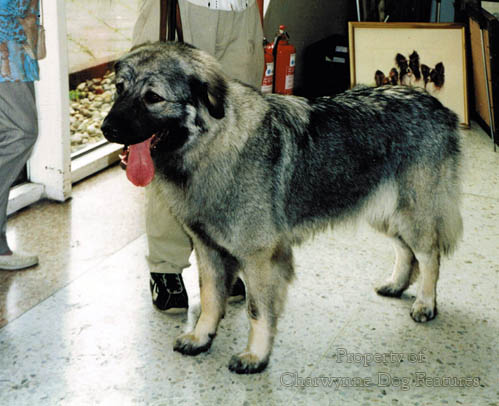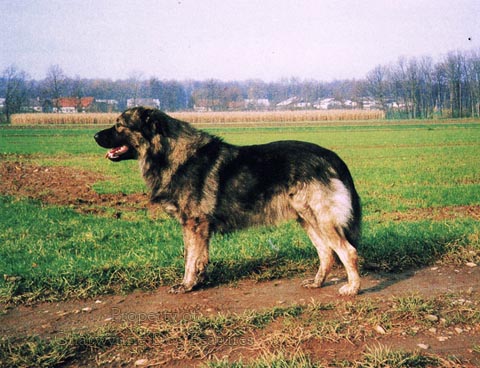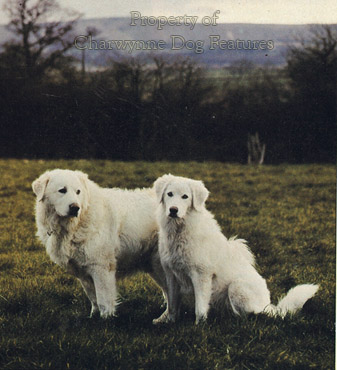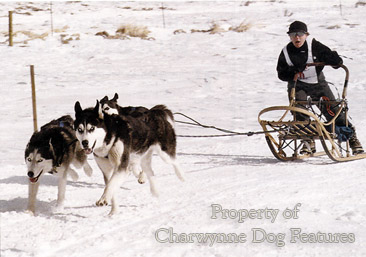363 Trading Places
TRADING PLACES - DOGS ON THE MOVE
by David Hancock
Dog-traders have earned themselves a somewhat dodgy reputation in modern times, but trading in dogs in past times has allowed the widespread movement of dogs and a wider appreciation of their usefulness. Dogs accompanied wandering tribes, campaigning armies and migrating peoples, provided they had some use. The game-catchers like the sighthound breeds, the gamefinders like the modern gundog breeds and the flock guarding breeds each had a distinct value to man. The need to control vermin led to the development of the terrier breeds. The need to control sheep gave us the herding breeds. Dogs which excelled in their specialist function have long been traded.
The particular function of each dog not surprisingly led to the development of the physique which allowed the dog to excel in that function. That is why sighthounds have a muscular light-boned build, the terriers a low-to-ground anatomy and the flock guardians substantial size. Sighthound breeds, wherever they were developed, project the same silhouette, display the same racy phenotype. The Azawakh of Mali, the Harehound of Circassia, the Sloughi of Morocco and the Tasy or Taigon from Mid-Asia would never change hands if they didn't look like fast-running dogs.
If they didn't possess this anatomical design they couldn't function as speedsters.
Hunters and sportsmen the world over know that the ability to catch game using speed demanded a very distinctive build. The sighthounds bound; they must have the height/weight ratio, the leg length and the liver-size to sprint. Sighthounds race entirely on liver glycogen, sugar activated from the liver. Sprinting demands long legs and a sizeable liver. The bigger the liver the more sugar can be stored. A sighthound over 65lbs in weight would have a problem through heat storage; their streamlined build allows a greater surface area. We are good at getting rid of excess heat and not very good at storing it. Dogs are the reverse, removing excess heat from their surfaces rather as a radiator gives off heat.
When sighthounds were traded, these technicalities were not known but the radiator-like build, size without weight and long legs meant something to their traders. The most successful sprinters had the build to succeed and were traded and perpetuated. In breeding for appearance only we need to bear in mind those anatomical essentials which made sighthounds what they are: internationally renowned sprinters. An 85lb Borzoi will experience difficulties when running flat out; a Greyhound of any weight with a small liver will have an even bigger handicap. Traders in such hounds couldn't measure livers but they could measure performance. Race your Afghans!

Similar but more perceptible criteria affect the flock guardian breeds. It is forgiveable to believe that such breeds are sizeable because they need to be able to see off wild animals which prey on sheep. But much more important are the bigger stride afforded by size, the ability to carry more fat reserves and store more heat than a small dog and to survive disease, severe weather and the odd accident - big bones break less easily than tiny ones. This is why such breeds possess a similar phenotype; the Slovenian Karst is easily confused with a Caucasian Owtcharka, or a Maremma with a Tatra Mountain Dog. The traders in such dogs knew what made a dog effective and therefore more valuable.




Traders in sled dogs made comparable judgements from their experiences. They learned to value economy of motion in their dogs; their gait leading to success, a smooth motion in which their feet hardly leave the ground. The top racing teams cover a mile in just over 3 minutes nowadays. This capability is rooted in the size-to-weight ratio. The dogs pull by pushing forward and the heavier the dog the greater the energy required to do so. A 50lb Alaskan hybrid husky has evolved as the optimum sled dog. Of course such a dog has to have the right feet, coat and constitution to support its work, but the relationship between height and weight is the key.

No doubt the show ring will dictate that sled dogs one day will be mainly valued for their coats, flock guardians for their size alone and the sighthound breeds for their sheer skinniness. They will be traded on cosmetic grounds alone and as breeds not functional creatures based on demanding criteria. This will please the kennel clubs of the world and make veterinary surgeons richer but will not do much for dogs. There is a wanton disregard for hybrid vigour amongst dog breeders and contemporary dog traders have learned that the closed gene pool in recognised breeds has to be respected for commercial success. Breed specific diseases are largely ignored.